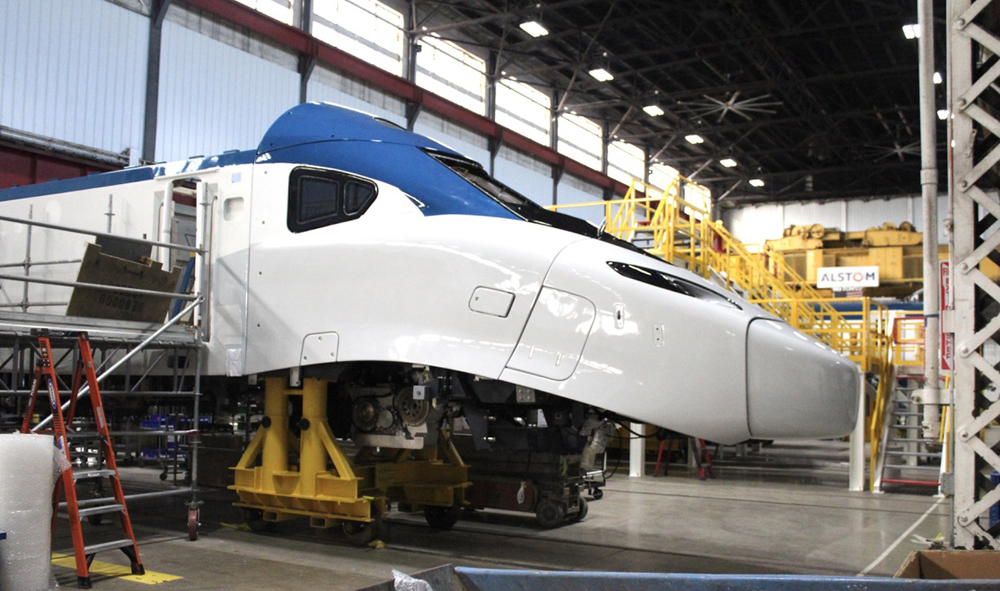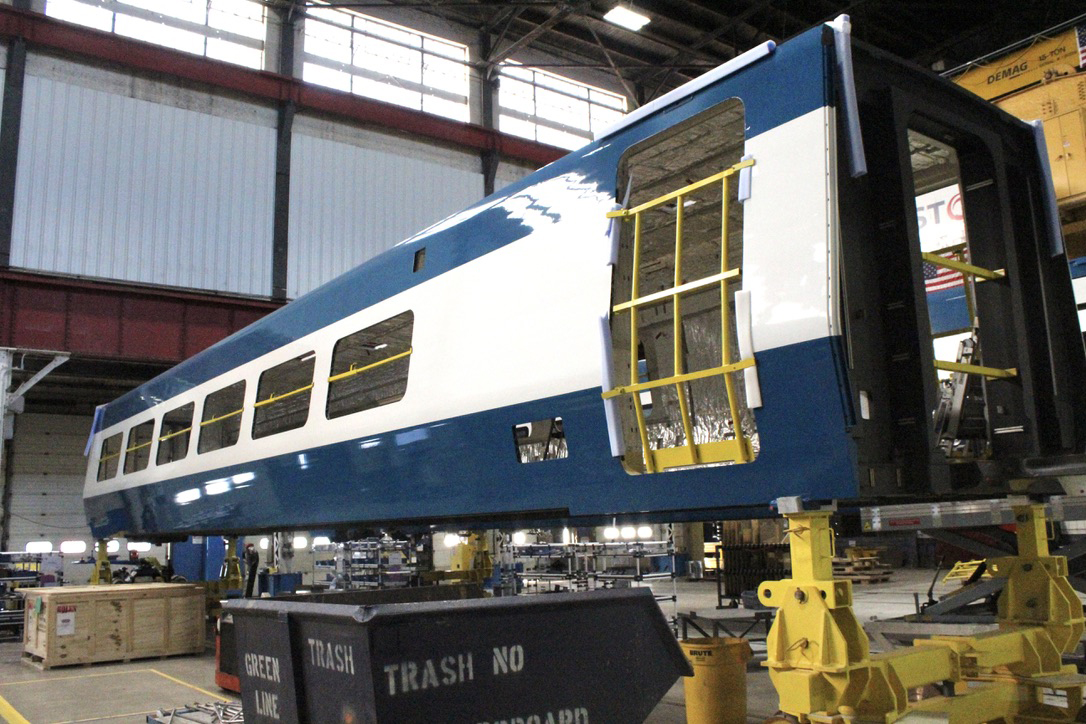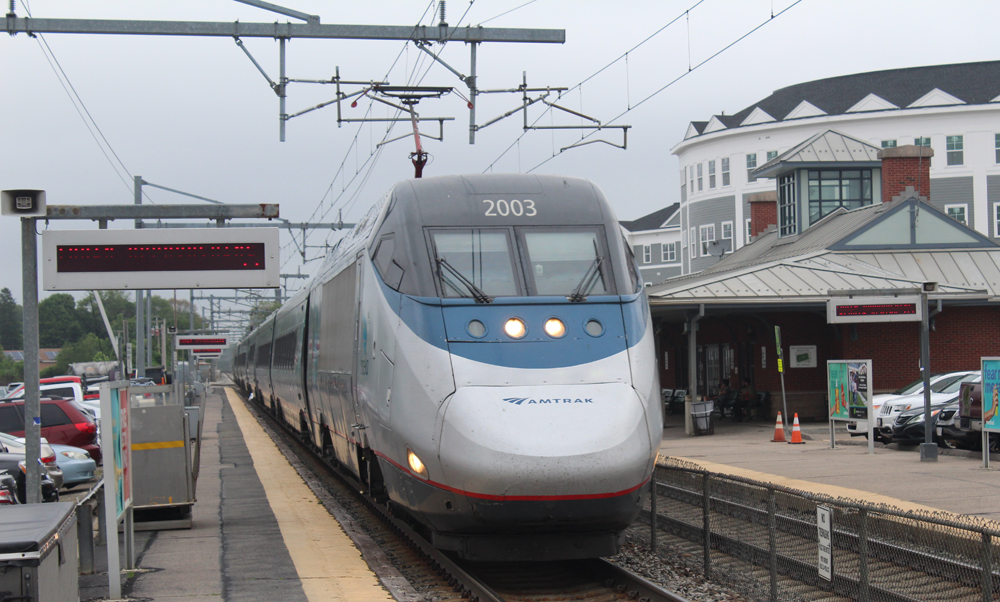
HORNELL, N.Y. — Testing of Amtrak’s next-generation Acela trainsets on the Northeast Corridor has shown that further modifications will be necessary, pushing back the date the equipment will be placed in service because additional testing will be necessary.
Amtrak revealed last week at a Philadelphia media event that the first of the 28 nine-unit trainsets being built by Alstom are not expected to enter revenue service until sometime in 2023 [see “News photos: Amtrak releases images of interiors for new Acelas,” Trains News Wire, April 1, 2022]. The debut originally expected in 2021 had been pushed back last year.

Amtrak says further computer modeling and simulation tests are required, explaining in a statement, “These are the first trainsets built under FRA’s Tier III rule, which sets new design specifications to allow for operation at the highest speeds and on shared corridors. We hope this will be the first of many trains built under this new framework and that the lessons learned here will benefit those efforts.”
The trainsets are 25% lighter than the current Acelas, which were built to earlier standards that required vehicles to not suffer structural degradation in a crash. The Tier III standards allow crush zones to absorb impacts, as long as the passenger compartment is designed to keep occupants safe. This is a standard used by European, Japanese, and Chinese trainset manufacturers to attain higher speeds when operated on dedicated right-of-way with tight track-variation tolerances.

Testing at the Association of American Railroads’ Transportation Technology Center in Pueblo, Colo., saw the train reach and exceed their rated speed of 160, but an integral part of any testing is evaluating performance where they will actually operate. On the Northeast Corridor from Washington, D.C., to Boston, operating conditions vary widely: Original Pennsylvania Railroad right-of-way from the nation’s capital to New York features everything from curving 1873-vintage tunnels under Baltimore to a recently-rejuvenated high-speed straightaway in New Jersey. North and east of New York is ex-New Haven Railroad curving trackage that had been a problem for the original Acelas, but the segment electrified and rebuilt from Connecticut to Boston in the late 1990s is already good for 160-mph operation.
In a statement to News Wire, Alstom says in that in modifications made after testing on the complete NEC route in a variety of conditions, “mass was added to the extremity ends of each car, and additional anti-roll bars were added to the café car to lower the center of gravity over specific wheels and to distribute load on wheels (to optimize) the trainset’s behavior on the curves of the NEC. These changes require updates to the computational model to validate the behavior of the trainsets in parallel to testing activities required by the Federal Railroad Administration (FRA) to enable a smooth introduction into revenue service.”
Asked whether adverse interaction with Amtrak’s ACSES positive train control system or electromagnetic interference was an issue, Alstom says, “The modeling activity encompasses all aspects of track conditions that can be experienced while traversing the NEC in revenue service, and is not specific to the signaling systems used.”
Alstom adds, “Given our 40+ years expertise in designing and manufacturing high speed trains, we do not anticipate any physical alterations. The completion of the modeling and simulation activities are expected to validate the design of the train and ensure the Federal Railroad Administration safety requirements are met.”
UPDATE on April 13, 2:00 p.m. CT: Alstom has clarified to News Wire that “no changes or modifications were made to the trainsets as a result of testing on the Northeast Corridor, and scheduled testing continues on the corridor at the present time.” The company adds that it, “continues to work with the project’s partners (Amtrak and the Federal Railroad Administration), to deliver a safe and reliable product to passengers, and will keep you apprised of the latest developments as we move closer towards that goal.”














On a semi related note, maybe with the delay Amtrak could get the paint scheme changed from 3rd world house paint to Phase 6 or 7 with some adjustment to have Acela 2 stand out a bit.
These are also a tried and proven European design. The issues involve modifying the European design for American use.
This is what happens when the lowest bidder is chosen. It is no wonder public projects become more expensive than the original lowest bidding.
Siemens builds tried and proven high speed passenger train fleets in Europe and Asia. They may be more expensive, but cheaper in the long term.
Mr. Shapp is correct. Only small parts of NHV-BOS are authorized 150 MPH.
As to the ex-PRR segment, you must understand the RR from Newark to Baltimore is made up of segments built in the 1830’s between the outskirts of the cities (as they were at that time). For example, in Philadelphia the RR from Northern New Jersey went to the Kensington neighborhood, and the RR to Baltimore left from Southwark on the opposite side of town. Both were in Philadelphia County but neither was in the City of Philadelphia. The curves at Frankford Jct. (50 MPH) and “ZOO” (30 MPH) connect the Philadelphia and Trenton with the Philadelphia, Wilmington and Baltimore.
To replace a horse-drawn movement in Baltimore City on Pratt St. PRR built the Baltimore and Potomac RR to Washington, including the B&P Tunnels. Amtrak is still using those tunnels.
Phil Mulligan
Mr. Johnson, what is the basis for your claim that some track segments east of New Haven and on to Boston are cleared for 160mph running? Admittedly it’s been at least three years since I’ve ridden an Acela NY-BOS but back then there were only two segments, both in Rhode Island, that were cleared for 150mph.
My wife and I would go from Central Berkshire County to Boston 4-5 times a year from 2008 until the pandemic hit and rode #2158 as the second leg of our trip. And nowhere but in those two above-cited segments were speeds up in the range of the mid-hundreds.
To clarify: only some short segments over which Amtrak hopes to operate the new trainsets “are good for” speeds of 160 mph but you are correct: current Acelas are limited to 150 mph there.
OMG Transparency from a transportation corporation!!! I think I am having a heart attack.
Just a slight peep thru the corporation fog of denial. Siemens probably did not understand how FRA crash requirements would need more understanding on the ancient PRR route as compared to the New Haven – BOS segment.
IMO the whole PRR right of way needs undercutting or maybe even removing track and starting over with compaction, fabric, new under grade, ballast, and track. Just shows how much deferred maintenance is going to cost Amtrak. Amtrak may need to close a 2-track section between CPs to do this work. No matter where these are going to be a real choke points.
What does Siemens have to with Alsthom? Siemens is building the new long distance diesels and Venture cars. Alsthom is building the new Acelas. Two different companies, two different manufacturing processes and equipment.
You ar absolutely correct. That is what I get for not proof reading before submitting. Of course, it is Alsthom not understanding the NEC,
A 100 mph Acela through Mansfield is just plain scary as you can see by the tight platforms in the photo. It’s a ROW shared with MBTA Providence trains and also freight movements between Selkirk and SE Mass. EB freight Mansfield – Attleboro goes WB on the corridor and vice-versa.
The Sharon – Mansfield segment is the highest-speed in Massachusetts and the highest in elevation anywhere in NEC.
That’s all fine, but how about the magnets under the tray tables?
The magnet issue is on the Siemens train sets.
Another one of my lame attempts at sarcasm gone awry.
Gee James, you really didn’t see that George was being sarcastic, maybe trying to inject a bit of levity in these troubling times?